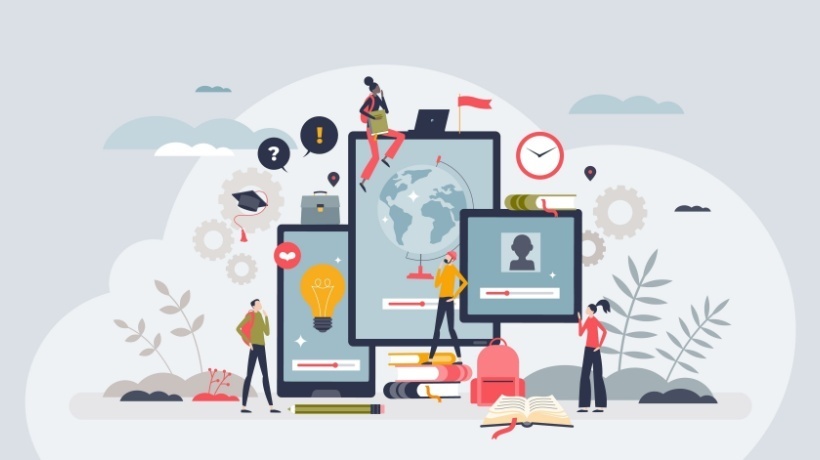A Call For More Intentional EdTech Innovation
In South Africa, teachers only spend 66% of classroom time teaching (12% below the international average), and almost half of these classrooms are over the recommended student-to-teacher ratio of 40:1. Having grown up in South Africa and having the privilege of attending good schools, I have always been determined to dedicate my professional life to fixing these types of issues. With that goal in mind, I entered Stanford in 2017 to study computer science, naively believing that a purely technology-based solution could solve these problems.
However, as I began to learn more about the state of education through books (like Poor Economics and Failure to Disrupt), together with my internship at Duolingo, and the research I've conducted for school and side projects, I have come to understand that technology alone is unlikely to fix what is, in many places, a broken system. Around the world, the rift that is education inequality seems to have widened, even as breakthrough technologies continue to disrupt and transform other industries.
And I'm not the only one who thought technology would have saved the day in education by now. EdTech evangelists have preached for the past several decades that we're on the brink of an education revolution, where consumer technology-driven online learning would have had more people receiving a quality education, at rates that are magnitudes better than before. This, simply put, has not happened. The most promising EdTech innovations, such as MOOCs (Massive Open Online Courses, e.g., Coursera, Udemy), haven’t had the massive impact we predicted; global literacy rates and education KPIs remain stagnant, or nominally improved at best. But why?
On a macro level, what is clear is that the "education system," while initially comprehensible as a single entity, is in fact an incredibly complex system of stakeholders which collectively does not react well to new technology products that attempt to mess with the status quo. The system is conservative. While there are exceptions, teachers that have access to new education technologies tend to use them to simply extend the same way that they have taught in the past, and parents expect their kids to receive an education that looked like the one they were given 30 years ago (Oriji et al speak of this in their research).
Drawing from the research of Justin Reich, director of the MIT Teaching Systems Lab and author of Failure to Disrupt, a couple of key product-level problems have been common among the technologies that have attempted to disrupt how we educate (and have not gone on to do so). Here is a couple of them:
Failure To Motivate
As has been the case with MOOCs, students are only good at progressing themselves through freely available coursework when they're passionate about what they're learning. These platforms often fail to move school students through subjects like mathematics and American History because these types of subjects need a teacher to provide the necessary extrinsic motivation to continue learning.
Overcrowding
Because one's education is incredibly multi-faceted, where students learn several subjects as part of a single education, we see a fragmented EdTech product landscape. We've tried sending kids home from school with 15 different EdTech products and platforms they're required to use, and it just doesn't work, says Reich. The logistical overhead of each service as well as the weak interoperability between the services are largely to blame.
But with these two pitfalls in mind, is there somewhere EdTech innovators can look to for examples of how we've 1) successfully motivated and re-engaged learners in a digital context, and 2) tied a fragmented product landscape together into a cohesive and synergistic product suite? Well, I'd like to propose that an area worth looking at is one we're all too familiar with: our favorite consumer technologies.
In The Case Of Motivation And Driving Re-Engagement
Popular consumer social apps (like TikTok, and Snapchat) and games (like Fortnite and Clash Royale) have mastered the art of getting their users back to the app daily. We all know somebody that regularly hops on Snapchat daily to save a streak or grind through levels on Clash Royale to climb the leaderboard. Of course, we are quick to point out how many of the methods through which these products create this engagement are ethically questionable. The increasing publicity around addictive tech has highlighted this, and rightly so. But can a case be made for leveraging several well-vetted, non-invasive engagement levers to drive young students to learn?
Perhaps the Duolingo language learning app is a pioneer in showing how this can be done effectively and responsibly. Duolingo, which makes all its learning content available on its free tier, experiences user retention rates like that of mobile games. Part of this can be attributed to their effective use of engagement levers that are common on consumer apps: Leaderboards and smart notifications incite healthy competition among users, and a daily streak counter has learners determined to complete—at the very least—one lesson each day.
In The Case Of Overcrowding
I venture that we can look to the Consumer Productivity sector for inspiration for effective interoperability and seamless integration. Products like Notion ("the all-in-one workspace") and Shift ("the app for streamlining your accounts") both directly address overcrowding.
Notion does so for our notes, wikis, and to-dos. Before, these knowledge banks would all live across 5-10 different apps and platforms. Now with Notion, users can create/import these knowledge banks in Notion and visualize them with Notion's native databases; their API, now in public Beta, welcomes the use of other services that integrate into your Notion workspace. Shift does a similar job for your connecting your communications apps to a dashboard, making for a single cohesive messaging experience.
It is with all this in mind that I stand convinced that motivation and cohesiveness across products must stand at the forefront of future EdTech offerings, and an appreciation for what's succeeding in the realm of consumer tech must be baked into projects going forward. With that said, it would be ignorant for me to believe that technology that ticks these boxes will alone solve the pressing issues that face the education system. A glitzy EdTech platform is useless if students don't have access to devices or knowledge of how to use them. A far bigger problem that ventures beyond the abilities of a single product is accessibility, and if we're aiming to ship products to the students who need it most, we need to place attention here too.
Research that discredits the impact of EdTech has grounded my dreams in reality. While initially disheartened, I perceive this as a call for more thoughtful innovation. I now consider myself an informed, yet still excited, technologist. Although I know that technology isn’t a magic wand solution and that the road ahead of me is complex, my dream of improving education through technology persists.









